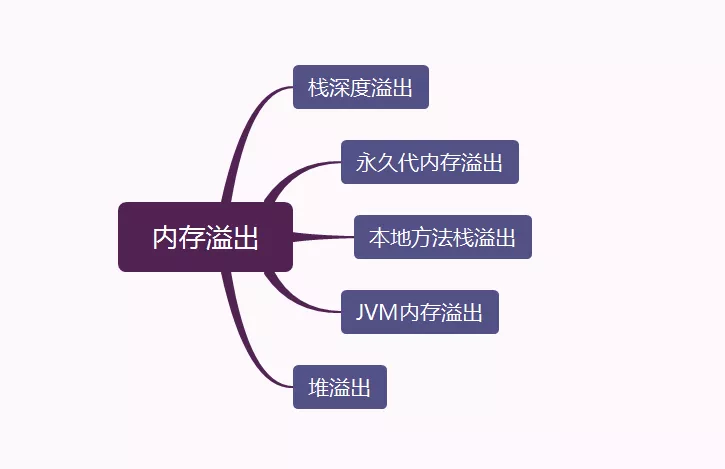定义主类结构
首先,创建一个名称为 BlowUpJVM 的类,之后所有的案例实验都是基于这个类进行,如下所示。
public class BlowUpJVM {}
栈深度溢出
public static void testStackOverFlow(){BlowUpJVM.testStackOverFlow();}
栈不断递归,而且没有处理,所以虚拟机栈就不断深入不断深入,栈深度就这样溢出了。
永久代内存溢出
public static void testPergemOutOfMemory1(){//方法一失败List<String> list = new ArrayList<String>();while(true){list.add(UUID.randomUUID().toString().intern());}}
打算把 String 常量池堆满,没想到失败了,JDK1.7 后常量池放到了堆里,也能进行垃圾回收了。
然后换种方式,使用 cglib,用 Class 把老年代堆满。
public static void testPergemOutOfMemory2(){try {while (true) {Enhancer enhancer = new Enhancer();enhancer.setSuperclass(OOM.class);enhancer.setUseCache(false);enhancer.setCallback(new MethodInterceptor() {@Overridepublic Object intercept(Object obj, Method method, Object[] args, MethodProxy proxy) throws Throwable {return proxy.invokeSuper(obj, args);}});enhancer.create();}}catch (Exception e){e.printStackTrace();}}
虚拟机成功内存溢出了,那 JDK 动态代理产生的类能不能溢出呢?
public static void testPergemOutOfMemory3(){while(true){final OOM oom = new OOM();Proxy.newProxyInstance(oom.getClass().getClassLoader(), oom.getClass().getInterfaces(), new InvocationHandler() {public Object invoke(Object proxy, Method method, Object[] args) throws Throwable {Object result = method.invoke(oom, args);return result;}});}}
事实表明,JDK 动态代理产生的类不会造成内存溢出,原因是:JDK 动态代理产生的类信息,不会放到永久代中,而是放在堆中。
本地方法栈溢出
public static void testNativeMethodOutOfMemory(){int j = 0;while(true){Printer.println(j++);ExecutorService executors = Executors.newFixedThreadPool(50);int i=0;while(i++<10){executors.submit(new Runnable() {public void run() {}});}}}
这个的原理就是不断创建线程池,而每个线程池都创建 10 个线程,这些线程池都是在本地方法区的,久而久之,本地方法区就溢出了。
JVM栈内存溢出
public static void testStackOutOfMemory(){while (true) {Thread thread = new Thread(new Runnable() {public void run() {while(true){}}});thread.start();}}
线程的创建会直接在 JVM 栈中创建,但是本例子中,没看到内存溢出,主机先挂了,不是 JVM 挂了,真的是主机挂了,无论在 mac 还是在 windows,都挂了。 :::danger 温馨提示,这个真的会死机的。 :::
堆溢出
public static void testOutOfHeapMemory(){List<StringBuffer> list = new ArrayList<StringBuffer>();while(true){StringBuffer B = new StringBuffer();for(int i = 0 ; i < 10000 ; i++){B.append(i);}list.add(B);}}
不断往堆中塞新增的 StringBuffer 对象,堆满了就直接溢出了。
测试案例完整代码
public class BlowUpJVM {//栈深度溢出public static void testStackOverFlow(){BlowUpJVM.testStackOverFlow();}//不能引起永久代溢出public static void testPergemOutOfMemory1(){//方法一失败List<String> list = new ArrayList<String>();while(true){list.add(UUID.randomUUID().toString().intern());}}//永久代溢出public static void testPergemOutOfMemory2(){try {while (true) {Enhancer enhancer = new Enhancer();enhancer.setSuperclass(OOM.class);enhancer.setUseCache(false);enhancer.setCallback(new MethodInterceptor() {@Overridepublic Object intercept(Object obj, Method method, Object[] args, MethodProxy proxy) throws Throwable {return proxy.invokeSuper(obj, args);}});enhancer.create();}}catch (Exception e){e.printStackTrace();}}//不会引起永久代溢出public static void testPergemOutOfMemory3(){while(true){final OOM oom = new OOM();Proxy.newProxyInstance(oom.getClass().getClassLoader(), oom.getClass().getInterfaces(), new InvocationHandler() {public Object invoke(Object proxy, Method method, Object[] args) throws Throwable {Object result = method.invoke(oom, args);return result;}});}}//本地方法栈溢出public static void testNativeMethodOutOfMemory(){int j = 0;while(true){Printer.println(j++);ExecutorService executors = Executors.newFixedThreadPool(50);int i=0;while(i++<10){executors.submit(new Runnable() {public void run() {}});}}}//JVM内存溢出public static void testStackOutOfMemory(){while (true) {Thread thread = new Thread(new Runnable() {public void run() {while(true){}}});thread.start();}}//堆溢出public static void testOutOfHeapMemory(){List<StringBuffer> list = new ArrayList<StringBuffer>();while(true){StringBuffer B = new StringBuffer();for(int i = 0 ; i < 10000 ; i++){B.append(i);}list.add(B);}}}


